2015 NISSAN TITAN maintenance
[x] Cancel search: maintenancePage 408 of 457
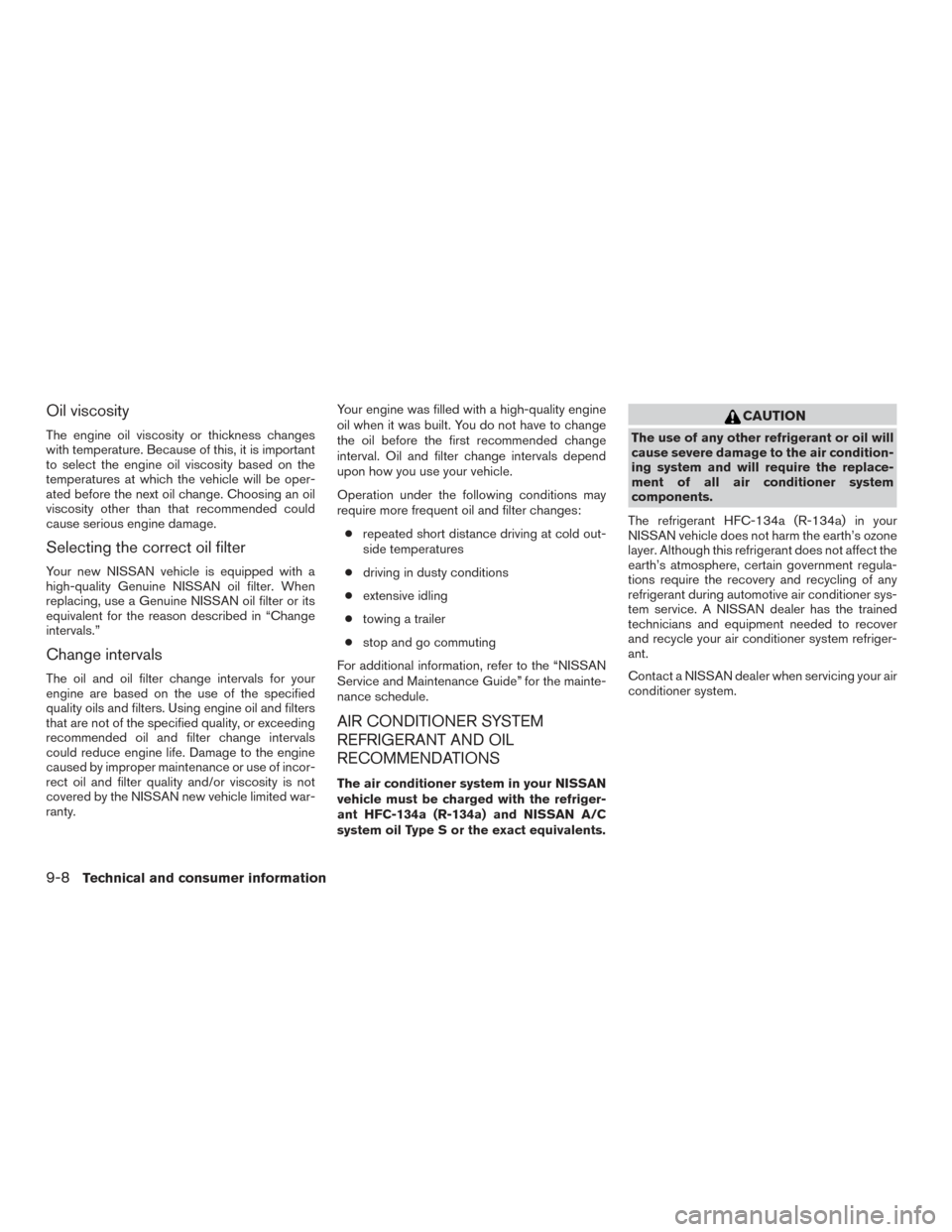
Oil viscosity
The engine oil viscosity or thickness changes
with temperature. Because of this, it is important
to select the engine oil viscosity based on the
temperatures at which the vehicle will be oper-
ated before the next oil change. Choosing an oil
viscosity other than that recommended could
cause serious engine damage.
Selecting the correct oil filter
Your new NISSAN vehicle is equipped with a
high-quality Genuine NISSAN oil filter. When
replacing, use a Genuine NISSAN oil filter or its
equivalent for the reason described in “Change
intervals.”
Change intervals
The oil and oil filter change intervals for your
engine are based on the use of the specified
quality oils and filters. Using engine oil and filters
that are not of the specified quality, or exceeding
recommended oil and filter change intervals
could reduce engine life. Damage to the engine
caused by improper maintenance or use of incor-
rect oil and filter quality and/or viscosity is not
covered by the NISSAN new vehicle limited war-
ranty.Your engine was filled with a high-quality engine
oil when it was built. You do not have to change
the oil before the first recommended change
interval. Oil and filter change intervals depend
upon how you use your vehicle.
Operation under the following conditions may
require more frequent oil and filter changes:
● repeated short distance driving at cold out-
side temperatures
● driving in dusty conditions
● extensive idling
● towing a trailer
● stop and go commuting
For additional information, refer to the “NISSAN
Service and Maintenance Guide” for the mainte-
nance schedule.
AIR CONDITIONER SYSTEM
REFRIGERANT AND OIL
RECOMMENDATIONS
The air conditioner system in your NISSAN
vehicle must be charged with the refriger-
ant HFC-134a (R-134a) and NISSAN A/C
system oil Type S or the exact equivalents.
CAUTION
The use of any other refrigerant or oil will
cause severe damage to the air condition-
ing system and will require the replace-
ment of all air conditioner system
components.
The refrigerant HFC-134a (R-134a) in your
NISSAN vehicle does not harm the earth’s ozone
layer. Although this refrigerant does not affect the
earth’s atmosphere, certain government regula-
tions require the recovery and recycling of any
refrigerant during automotive air conditioner sys-
tem service. A NISSAN dealer has the trained
technicians and equipment needed to recover
and recycle your air conditioner system refriger-
ant.
Contact a NISSAN dealer when servicing your air
conditioner system.
9-8Technical and consumer information
Page 439 of 457
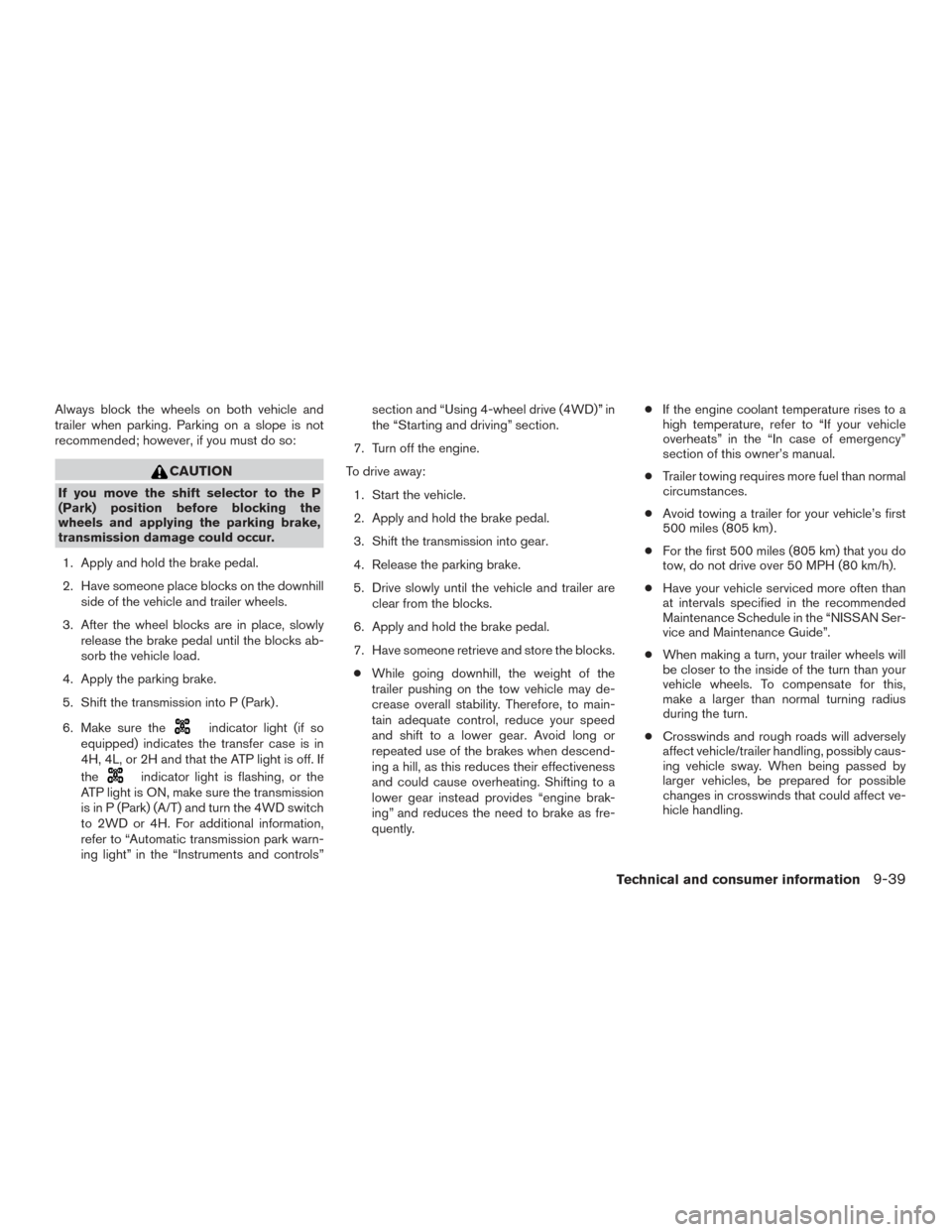
Always block the wheels on both vehicle and
trailer when parking. Parking on a slope is not
recommended; however, if you must do so:
CAUTION
If you move the shift selector to the P
(Park) position before blocking the
wheels and applying the parking brake,
transmission damage could occur.1. Apply and hold the brake pedal.
2. Have someone place blocks on the downhill side of the vehicle and trailer wheels.
3. After the wheel blocks are in place, slowly release the brake pedal until the blocks ab-
sorb the vehicle load.
4. Apply the parking brake.
5. Shift the transmission into P (Park) .
6. Make sure the
indicator light (if so
equipped) indicates the transfer case is in
4H, 4L, or 2H and that the ATP light is off. If
the
indicator light is flashing, or the
ATP light is ON, make sure the transmission
is in P (Park) (A/T) and turn the 4WD switch
to 2WD or 4H. For additional information,
refer to “Automatic transmission park warn-
ing light” in the “Instruments and controls” section and “Using 4-wheel drive (4WD)” in
the “Starting and driving” section.
7. Turn off the engine.
To drive away: 1. Start the vehicle.
2. Apply and hold the brake pedal.
3. Shift the transmission into gear.
4. Release the parking brake.
5. Drive slowly until the vehicle and trailer are clear from the blocks.
6. Apply and hold the brake pedal.
7. Have someone retrieve and store the blocks. ● While going downhill, the weight of the
trailer pushing on the tow vehicle may de-
crease overall stability. Therefore, to main-
tain adequate control, reduce your speed
and shift to a lower gear. Avoid long or
repeated use of the brakes when descend-
ing a hill, as this reduces their effectiveness
and could cause overheating. Shifting to a
lower gear instead provides “engine brak-
ing” and reduces the need to brake as fre-
quently. ●
If the engine coolant temperature rises to a
high temperature, refer to “If your vehicle
overheats” in the “In case of emergency”
section of this owner’s manual.
● Trailer towing requires more fuel than normal
circumstances.
● Avoid towing a trailer for your vehicle’s first
500 miles (805 km) .
● For the first 500 miles (805 km) that you do
tow, do not drive over 50 MPH (80 km/h).
● Have your vehicle serviced more often than
at intervals specified in the recommended
Maintenance Schedule in the “NISSAN Ser-
vice and Maintenance Guide”.
● When making a turn, your trailer wheels will
be closer to the inside of the turn than your
vehicle wheels. To compensate for this,
make a larger than normal turning radius
during the turn.
● Crosswinds and rough roads will adversely
affect vehicle/trailer handling, possibly caus-
ing vehicle sway. When being passed by
larger vehicles, be prepared for possible
changes in crosswinds that could affect ve-
hicle handling.
Technical and consumer information9-39
Page 440 of 457
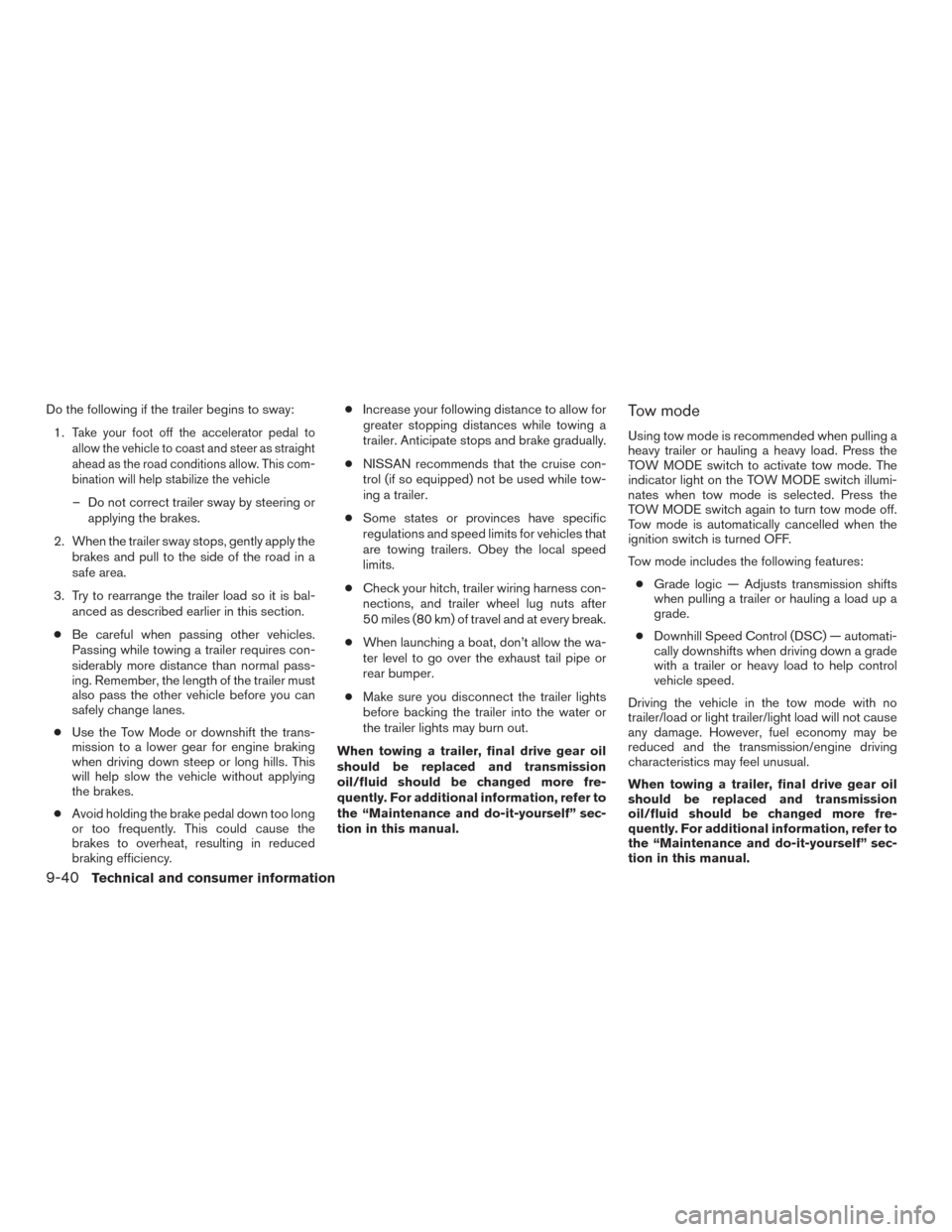
Do the following if the trailer begins to sway:1.
Take your foot off the accelerator pedal to
allow the vehicle to coast and steer as straight
ahead as the road conditions allow. This com-
bination will help stabilize the vehicle
– Do not correct trailer sway by steering or applying the brakes.
2. When the trailer sway stops, gently apply the brakes and pull to the side of the road in a
safe area.
3. Try to rearrange the trailer load so it is bal- anced as described earlier in this section.
● Be careful when passing other vehicles.
Passing while towing a trailer requires con-
siderably more distance than normal pass-
ing. Remember, the length of the trailer must
also pass the other vehicle before you can
safely change lanes.
● Use the Tow Mode or downshift the trans-
mission to a lower gear for engine braking
when driving down steep or long hills. This
will help slow the vehicle without applying
the brakes.
● Avoid holding the brake pedal down too long
or too frequently. This could cause the
brakes to overheat, resulting in reduced
braking efficiency. ●
Increase your following distance to allow for
greater stopping distances while towing a
trailer. Anticipate stops and brake gradually.
● NISSAN recommends that the cruise con-
trol (if so equipped) not be used while tow-
ing a trailer.
● Some states or provinces have specific
regulations and speed limits for vehicles that
are towing trailers. Obey the local speed
limits.
● Check your hitch, trailer wiring harness con-
nections, and trailer wheel lug nuts after
50 miles (80 km) of travel and at every break.
● When launching a boat, don’t allow the wa-
ter level to go over the exhaust tail pipe or
rear bumper.
● Make sure you disconnect the trailer lights
before backing the trailer into the water or
the trailer lights may burn out.
When towing a trailer, final drive gear oil
should be replaced and transmission
oil/fluid should be changed more fre-
quently. For additional information, refer to
the “Maintenance and do-it-yourself” sec-
tion in this manual.
Tow mode
Using tow mode is recommended when pulling a
heavy trailer or hauling a heavy load. Press the
TOW MODE switch to activate tow mode. The
indicator light on the TOW MODE switch illumi-
nates when tow mode is selected. Press the
TOW MODE switch again to turn tow mode off.
Tow mode is automatically cancelled when the
ignition switch is turned OFF.
Tow mode includes the following features: ● Grade logic — Adjusts transmission shifts
when pulling a trailer or hauling a load up a
grade.
● Downhill Speed Control (DSC) — automati-
cally downshifts when driving down a grade
with a trailer or heavy load to help control
vehicle speed.
Driving the vehicle in the tow mode with no
trailer/load or light trailer/light load will not cause
any damage. However, fuel economy may be
reduced and the transmission/engine driving
characteristics may feel unusual.
When towing a trailer, final drive gear oil
should be replaced and transmission
oil/fluid should be changed more fre-
quently. For additional information, refer to
the “Maintenance and do-it-yourself” sec-
tion in this manual.
9-40Technical and consumer information
Page 444 of 457
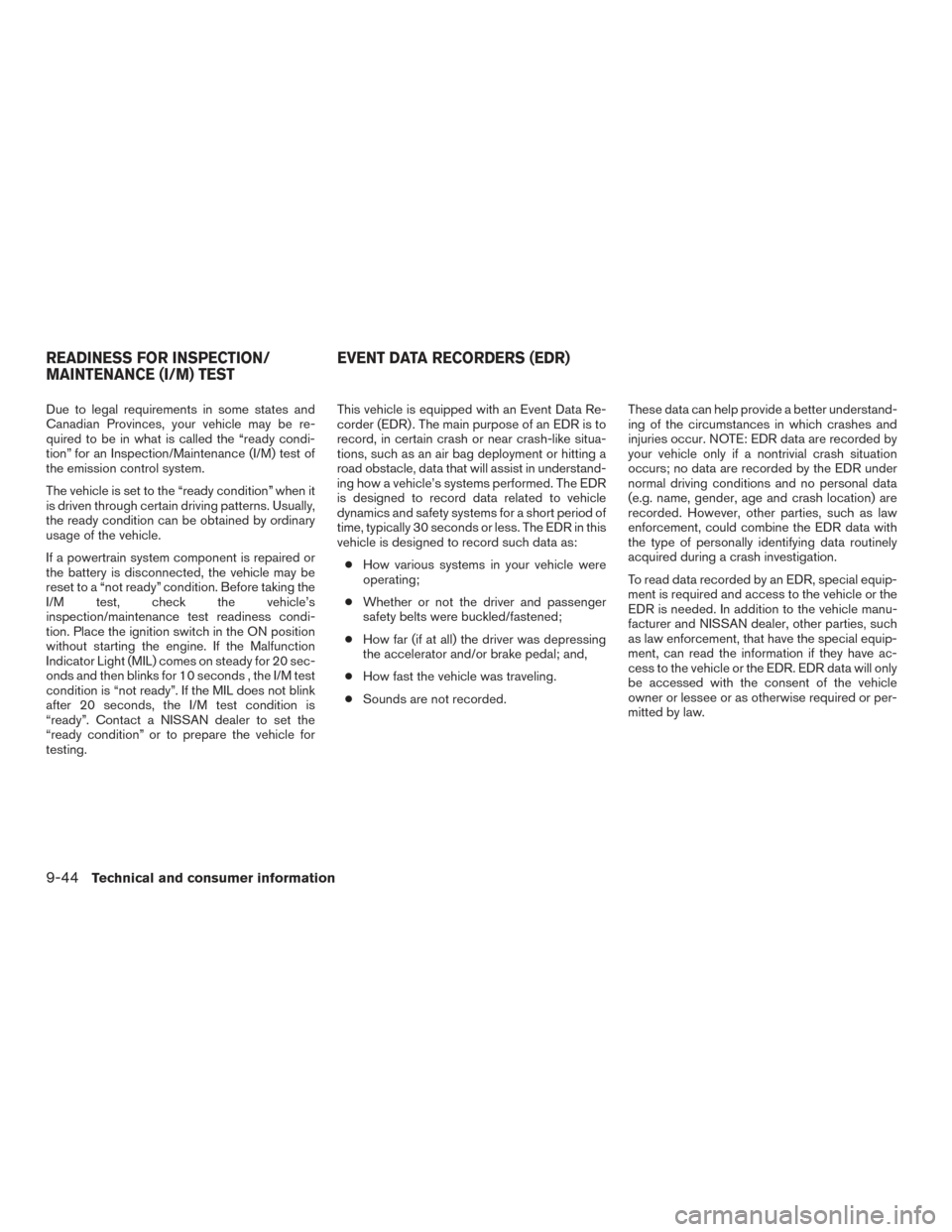
Due to legal requirements in some states and
Canadian Provinces, your vehicle may be re-
quired to be in what is called the “ready condi-
tion” for an Inspection/Maintenance (I/M) test of
the emission control system.
The vehicle is set to the “ready condition” when it
is driven through certain driving patterns. Usually,
the ready condition can be obtained by ordinary
usage of the vehicle.
If a powertrain system component is repaired or
the battery is disconnected, the vehicle may be
reset to a “not ready” condition. Before taking the
I/M test, check the vehicle’s
inspection/maintenance test readiness condi-
tion. Place the ignition switch in the ON position
without starting the engine. If the Malfunction
Indicator Light (MIL) comes on steady for 20 sec-
onds and then blinks for 10 seconds , the I/M test
condition is “not ready”. If the MIL does not blink
after 20 seconds, the I/M test condition is
“ready”. Contact a NISSAN dealer to set the
“ready condition” or to prepare the vehicle for
testing.This vehicle is equipped with an Event Data Re-
corder (EDR) . The main purpose of an EDR is to
record, in certain crash or near crash-like situa-
tions, such as an air bag deployment or hitting a
road obstacle, data that will assist in understand-
ing how a vehicle’s systems performed. The EDR
is designed to record data related to vehicle
dynamics and safety systems for a short period of
time, typically 30 seconds or less. The EDR in this
vehicle is designed to record such data as:
● How various systems in your vehicle were
operating;
● Whether or not the driver and passenger
safety belts were buckled/fastened;
● How far (if at all) the driver was depressing
the accelerator and/or brake pedal; and,
● How fast the vehicle was traveling.
● Sounds are not recorded. These data can help provide a better understand-
ing of the circumstances in which crashes and
injuries occur. NOTE: EDR data are recorded by
your vehicle only if a nontrivial crash situation
occurs; no data are recorded by the EDR under
normal driving conditions and no personal data
(e.g. name, gender, age and crash location) are
recorded. However, other parties, such as law
enforcement, could combine the EDR data with
the type of personally identifying data routinely
acquired during a crash investigation.
To read data recorded by an EDR, special equip-
ment is required and access to the vehicle or the
EDR is needed. In addition to the vehicle manu-
facturer and NISSAN dealer, other parties, such
as law enforcement, that have the special equip-
ment, can read the information if they have ac-
cess to the vehicle or the EDR. EDR data will only
be accessed with the consent of the vehicle
owner or lessee or as otherwise required or per-
mitted by law.
READINESS FOR INSPECTION/
MAINTENANCE (I/M) TEST
EVENT DATA RECORDERS (EDR)
9-44Technical and consumer information
Page 449 of 457
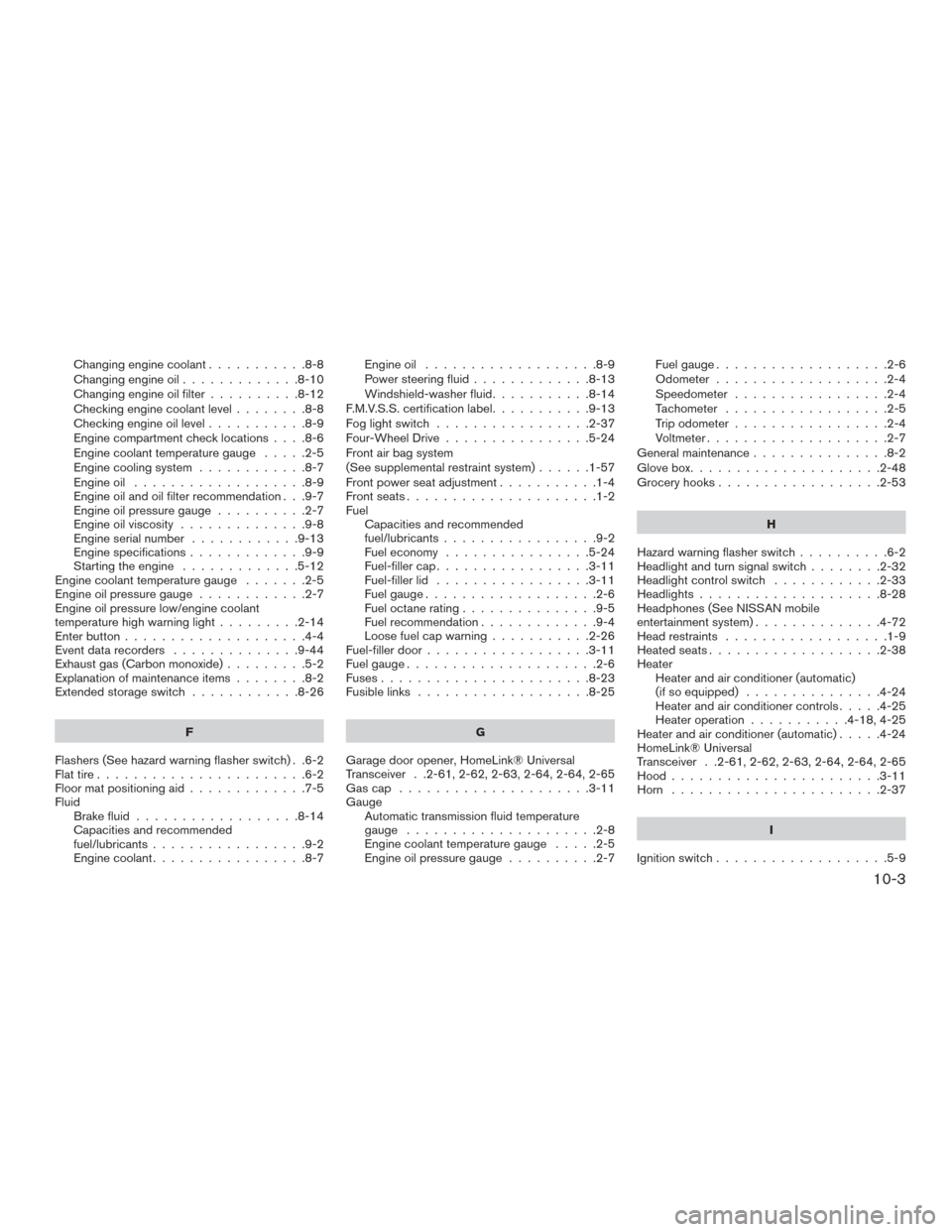
Changing engine coolant...........8-8
Changing engine oil .............8-10
Changing engine oil filter ..........8-12
Checking engine coolant level ........8-8
Checking engine oil level ...........8-9
Engine compartment check locations ....8-6
Engine coolant temperature gauge .....2-5
Engine cooling system ............8-7
Engine oil ...................8-9
Engine oil and oil filter recommendation . . .9-7
Engine oil pressure gauge ..........2-7
Engine oil viscosity ..............9-8
Engine serial number ............9-13
Engine specifications .............9-9
Starting the engine .............5-12
Engine coolant temperature gauge .......2-5
Engineoilpressuregauge............2-7
Engine oil pressure low/engine coolant
temperature high warning light .........2-14
Enterbutton....................4-4
Event data recorders ..............9-44
Exhaust gas (Carbon monoxide) .........5-2
Explanation of maintenance items ........8-2
Extendedstorageswitch ............8-26
F
Flashers (See hazard warning flasher switch) . .6-2
Flat tire .......................6-2
Floor mat positioning aid .............7-5
Fluid Brake fluid ..................8-14
Capacities and recommended
fuel/lubricants .................9-2
Engine coolant .................8-7 Engine oil
...................8-9
Power steering fluid .............8-13
Windshield-washer fluid ...........8-14
F.M.V.S.S. certification label ...........9-13
Foglightswitch .................2-37
Four-Wheel Drive ................5-24
Front air bag system
(See supplemental restraint system) ......1-57
Front power seat adjustment ...........1-4
Frontseats.....................1-2
Fuel Capacities and recommended
fuel/lubricants .................9-2
Fuel economy ................5-24
Fuel-filler cap .................3-11
Fuel-filler lid .................3-11
Fuel gauge ...................2-6
Fuel octane rating ...............9-5
Fuel recommendation .............9-4
Loose fuel cap warning ...........2-26
Fuel-filler door ..................3-11
Fuelgauge.....................2-6
Fuses.......................8-23
Fusiblelinks ...................8-25
G
Garage door opener, HomeLink® Universal
Transceiver . .2-61, 2-62, 2-63, 2-64, 2-64, 2-65
Gascap .....................3-11
Gauge Automatic transmission fluid temperature
gauge .....................2-8
Engine coolant temperature gauge .....2-5
Engine oil pressure gauge ..........2-7 Fuelgauge...................2-6
Odometer
...................2-4
Speedometer .................2-4
Tachometer ..................2-5
Trip odometer .................2-4
Voltmeter ....................2-7
General
maintenance ...............8-2
Glovebox.....................2-48
Groceryhooks..................2-53
H
Hazard warning flasher switch ..........6-2
Headlightandturnsignalswitch........2-32
Headlightcontrolswitch ............2-33
Headlights....................8-28
Headphones (See NISSAN mobile
entertainment system) ..............4-72
Head restraints ..................1-9
Heated seats ...................2-38
Heater Heater and air conditioner (automatic)
(if so equipped) ...............4-24
Heater and air conditioner controls .....4-25
Heater operation ...........4-18,4-25
Heater and air conditioner (automatic) .....4-24
HomeLink® Universal
Transceiver . .2-61, 2-62, 2-63, 2-64, 2-64, 2-65
Hood.......................3-11
Horn .......................2-37
I
Ignition switch ...................5-9
10-3
Page 450 of 457
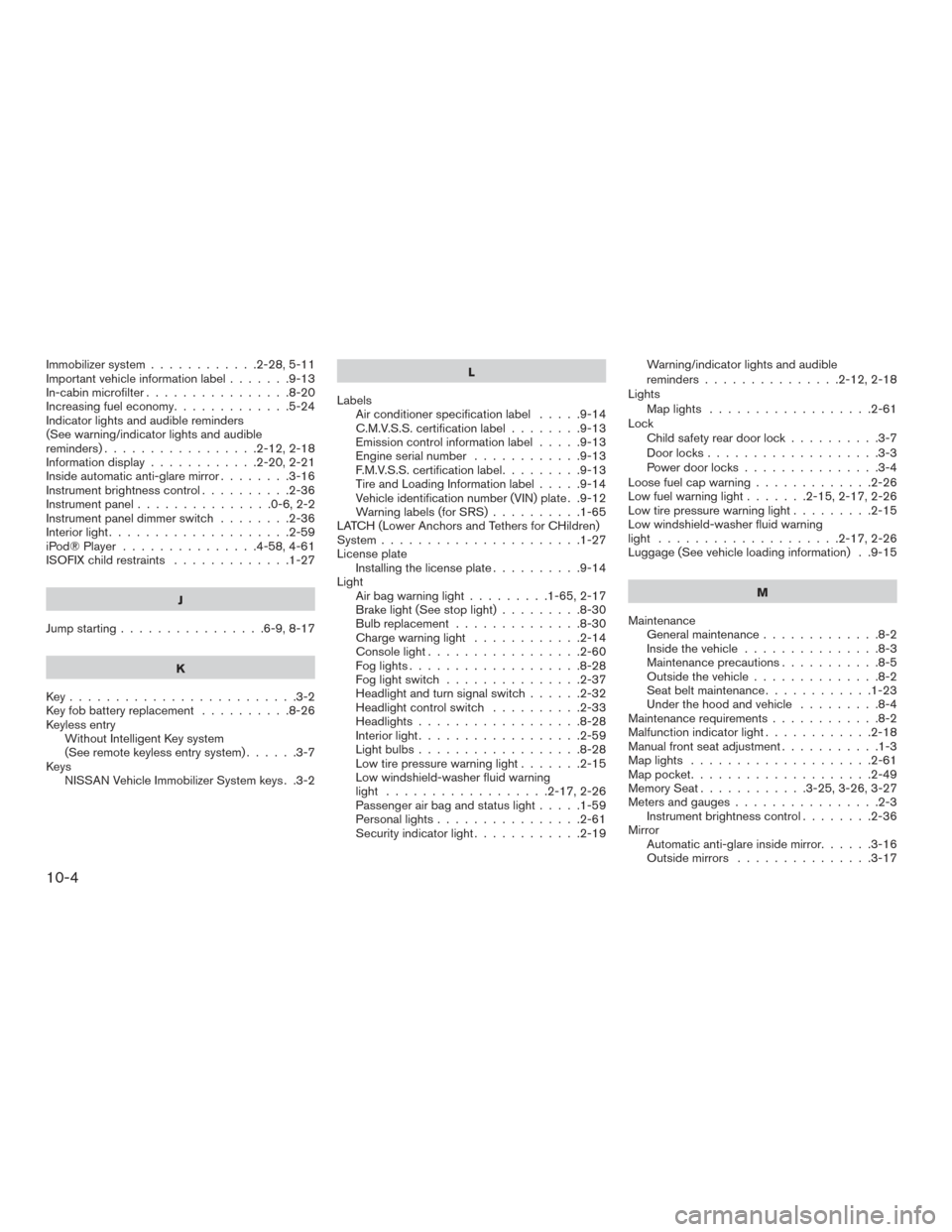
Immobilizer system............2-28,5-11
Important vehicle information label .......9-13
In-cabin microfilter ................8-20
Increasing fuel economy .............5-24
Indicator lights and audible reminders
(See warning/indicator lights and audible
reminders).................2-12,2-18
Informationdisplay............2-20,2-21
Inside automatic anti-glare mirror ........3-16
Instrument brightness control ..........2-36
Instrument panel ...............0-6,2-2
Instrument panel dimmer switch ........2-36
Interiorlight....................2-59
iPod®Player ...............4-58,4-61
ISOFIX child restraints .............1-27
J
Jump starting ................6-9,8-17
K
Key.........................3-2
Key fob battery replacement ..........8-26
Keyless entry Without Intelligent Key system
(See remote keyless entry system) ......3-7
Keys NISSAN Vehicle Immobilizer System keys . .3-2 L
Labels Air conditioner specification label .....9-14
C.M.V.S.S. certification label ........9-13
Emission control information label .....9-13
Engine serial number ............9-13
F.M.V.S.S. certification label .........9-13
Tire and Loading Information label .....9-14
Vehicle identification number (VIN) plate . .9-12
Warning labels (for SRS) ..........1-65
LATCH (Lower Anchors and Tethers for CHildren)
System ......................1-27
License plate Installing the license plate ..........9-14
Light Air bag warning light .........1-65,2-17
Brake light (See stop light) .........8-30
Bulbreplacement..............8-30
Charge warning light ............2-14
Consolelight.................2-60
Foglights...................8-28
Foglightswitch ...............2-37
Headlight and turn signal switch ......2-32
Headlight control switch ..........2-33
Headlights..................8-28
Interiorlight..................2-59
Lightbulbs..................8-28
Low tire pressure warning light .......2-15
Low windshield-washer fluid warning
light ..................2-17,2-26
Passenger air bag and status light .....1-59
Personal lights ................2-61
Security indicator light ............2-19 Warning/indicator lights and audible
reminders
...............2-12,2-18
Lights Maplights ..................2-61
Lock Child safety rear door lock ..........3-7
Door locks ...................3-3
Power door locks ...............3-4
Loose fuel cap warning .............2-26
Low fuel warning light .......2-15,2-17,2-26
Low tire pressure warning light .........2-15
Low windshield-washer fluid warning
light ....................2-17,2-26
Luggage (See vehicle loading information) . .9-15
M
Maintenance General maintenance .............8-2
Insidethevehicle...............8-3
Maintenance precautions ...........8-5
Outside the vehicle ..............8-2
Seat belt maintenance ............1-23
Under the hood and vehicle .........8-4
Maintenance
requirements ............8-2
Malfunction indicator light ............2-18
Manual front seat adjustment ...........1-3
Maplights ....................2-61
Mappocket....................2-49
Memory Seat ............3-25,3-26,3-27
Meters and gauges ................2-3
Instrument brightness control ........2-36
Mirror Automatic anti-glare inside mirror ......3-16
Outside mirrors ...............3-17
10-4
Page 451 of 457

Rearview...................3-16
Vanity mirror .................3-15
Moonroof .....................2-58
N
NISSAN mobile entertainment system
(MES) .........4-69,4-70,4-71,4-72,4-76
NISSAN vehicle immobilizer system . . .2-28, 5-11
NISSAN voice recognition system .......4-98
O
Octanerating(Seefueloctanerating)......9-5
Odometer .....................2-4
Oil Capacities and recommended
fuel/lubricants .................9-2
Changing engine oil .............8-10
Changing engine oil filter ..........8-12
Checking engine oil level ...........8-9
Engine oil ...................8-9
Engine oil and oil filter recommendation . . .9-7
Engine oil pressure low/engine coolant
temperature high warning light .......2-14
Engine oil viscosity ..............9-8
Oneshotcall...............4-82,4-93
Outside mirrors .................3-17
Overhead console ................2-50
Overheat Ifyourvehicleoverheats...........6-11
Owner’s manual order form ...........9-45
Owner’s manual/service manual order
information ....................9-45 P
Parking Parking brake operation ...........5-20
Parking/parking on hills ...........5-32
Pedal position adjustment ............3-14
Personallights..................2-61
Power Front seat adjustment .............1-4
Power door locks ...............3-4
Power outlet ..............2-42,2-44
Power rear windows .............2-56
Power steering fluid .............8-13
Power steering system ...........5-33
Power windows ...............2-54
Rear power windows ............2-56
Power inverter switch ..............2-40
Power outlet ................2-42,2-44
Power steering ..................5-33
Power steering fluid ...............8-13
Precautions Maintenance precautions ...........8-5
On-pavement and off-road driving
precautions ..................5-5
Precautions on booster
seats...........1-25,1-32,1-39,1-46
Precautions on child
restraints .........1-25,1-32,1-39,1-46
Precautions on seat belt usage .......1-14
Precautions on supplemental restraint
system ....................1-50
Precautions when starting and
driving ...................5-2,5-7
Pre-tensioner seat belt system .........1-64
Programmablefeatures..............4-7 Push starting
...................6-11
R
Radio AM-FM radio with compact disc
(CD)player..................4-35
CarphoneorCBradio ...........4-79
FM/AM radio with compact disc
(CD)player..................4-35
FM-AM radio with compact disc
(CD)player..................4-39
FM/AM radio with compact disc
(CD)player..................4-39
FM/AM/SAT radio with compact disc (CD)
player .................4-43,4-48
Steering wheel audio control switch . . . .4-67
Readiness for inspection maintenance
(I/M)
test.....................9-44
Rear power windows ..............2-56
Rear sliding window ...............2-57
Rear sonar system ................5-38
Rear sonar system off switch ..........2-41
Rearview mirror .................3-16
RearView Monitor ......4-10,4-11,4-13,4-14
Rear window and outside mirror defroster
switch.......................2-31
Recorders Eventdata..................9-44
Refrigerant recommendation ...........9-8
Registering your vehicle in another country . .9-12
Remote controller (See NISSAN mobile
entertainment system) ..............4-71
Remote keyless entry system ...........3-7
Reporting safety defects (US only) .......9-43
10-5
Page 452 of 457
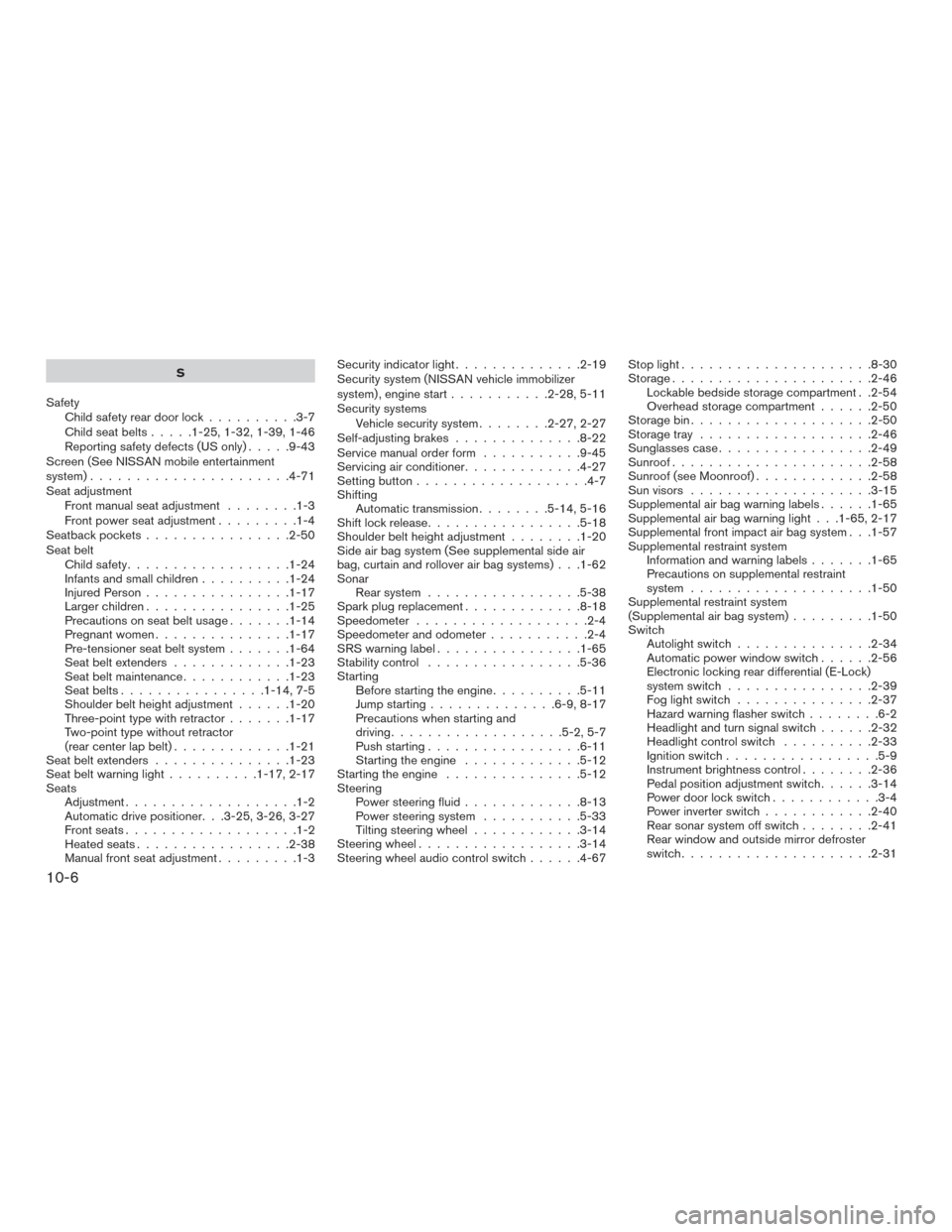
S
Safety Child safety rear door lock ..........3-7
Childseatbelts.....1-25,1-32,1-39,1-46
Reporting safety defects (US only) .....9-43
Screen (See NISSAN mobile entertainment
system)......................4-71
Seat adjustment Front manual seat adjustment ........1-3
Front power seat adjustment .........1-4
Seatback pockets ................2-50
Seat belt Childsafety..................1-24
Infantsandsmallchildren..........1-24
Injured Person ................1-17
Largerchildren................1-25
Precautionsonseatbeltusage.......1-14
Pregnant women ...............1-17
Pre-tensioner seat belt system .......1-64
Seat belt extenders .............1-23
Seat belt maintenance ............1-23
Seat belts ................1-14,7-5
Shoulder belt height adjustment ......1-20
Three-point type with retractor .......1-17
Two-point type without retractor
(rear center lap belt) .............1-21
Seat belt extenders ...............1-23
Seatbeltwarninglight..........1-17,2-17
Seats Adjustment ...................1-2
Automatic drive positioner. . .3-25, 3-26, 3-27
Frontseats...................1-2
Heatedseats.................2-38
Manual front seat adjustment .........1-3Security indicator light
..............2-19
Security system (NISSAN vehicle immobilizer
system) , engine start ...........2-28,5-11
Security systems Vehicle security system ........2-27,2-27
Self-adjusting brakes ..............8-22
Service manual order form ...........9-45
Servicing air conditioner .............4-27
Setting button ...................4-7
Shifting Automatic transmission ........5-14,5-16
Shiftlockrelease.................5-18
Shoulder belt height adjustment ........1-20
Side air bag system (See supplemental side air
bag, curtain and rollover air bag systems) . . .1-62
Sonar Rear system .................5-38
Sparkplugreplacement.............8-18
Speedometer ...................2-4
Speedometer and odometer ...........2-4
SRSwarninglabel................1-65
Stability control .................5-36
Starting Before starting the engine ..........5-11
Jump starting ..............6-9,8-17
Precautions when starting and
driving ...................5-2,5-7
Push starting .................6-11
Starting the engine .............5-12
Starting the engine ...............5-12
Steering Power steering fluid .............8-13
Power steering system ...........5-33
Tilting steering wheel ............3-14
Steeringwheel..................3-14
Steering wheel audio control switch ......4-67Stoplight.....................8-30
Storage......................2-46
Lockable bedside storage compartment . .2-54
Overhead storage compartment ......2-50
Storagebin....................2-50
Storage tray ...................2-46
Sunglasses case .................2-49
Sunroof......................2-58
Sunroof(seeMoonroof).............2-58
Sun visors ....................
3-15
Supplemental air bag warning labels ......1-65
Supplemental air bag warning light . . .1-65, 2-17
Supplemental front impact air bag system . . .1-57
Supplemental restraint system Information and warning labels .......1-65
Precautions on supplemental restraint
system ....................1-50
Supplemental restraint system
(Supplemental air bag system) .........1-50
Switch Autolightswitch...............2-34
Automatic power window switch ......2-56
Electronic locking rear differential (E-Lock)
system switch ................2-39
Fog light switch ...............2-37
Hazard warning flasher switch ........6-2
Headlightandturnsignalswitch......2-32
Headlight control switch ..........2-33
Ignition switch .................5-9
Instrument brightness control ........2-36
Pedal position adjustment switch ......3-14
Power door lock switch ............3-4
Power inverter switch ............2-40
Rear sonar system off switch ........2-41
Rear window and outside mirror defroster
switch .....................2-31
10-6